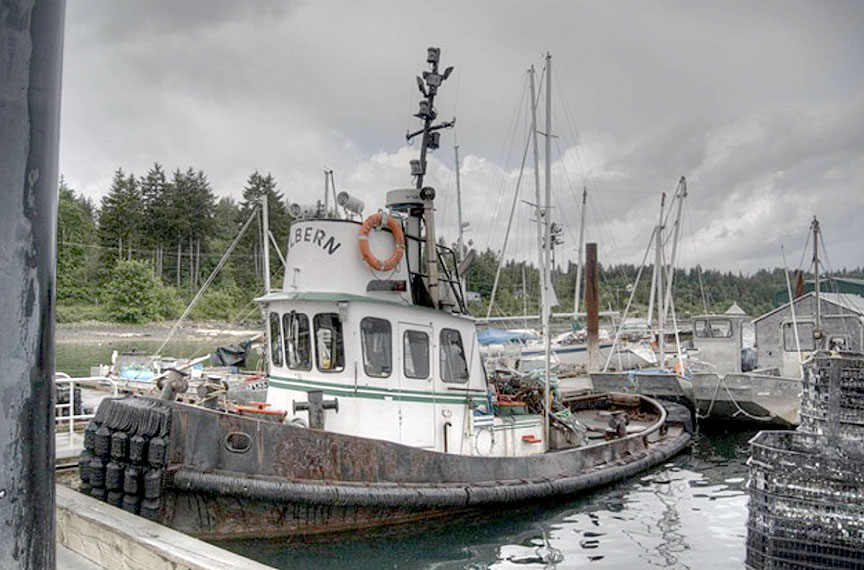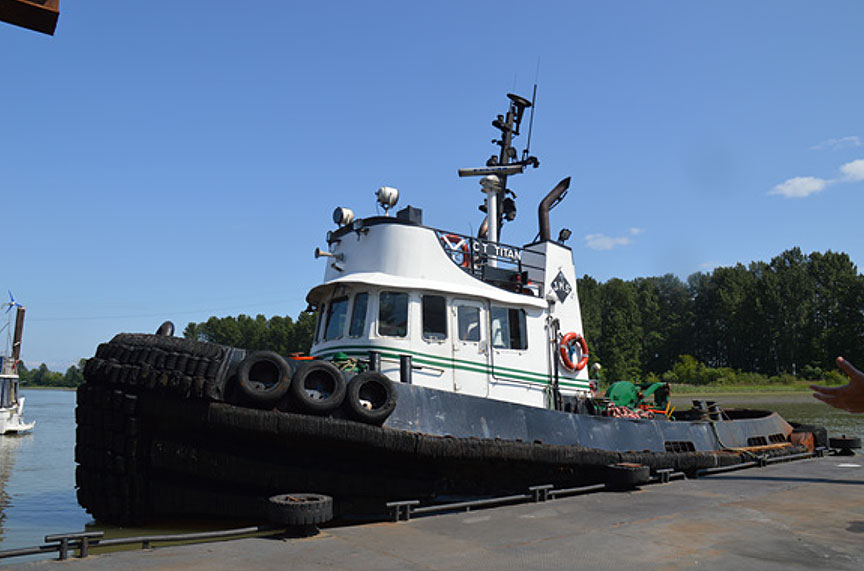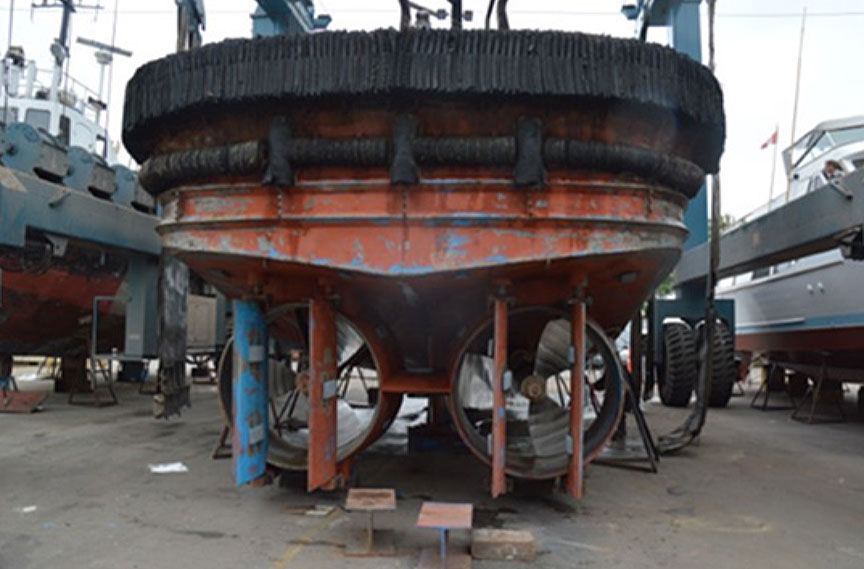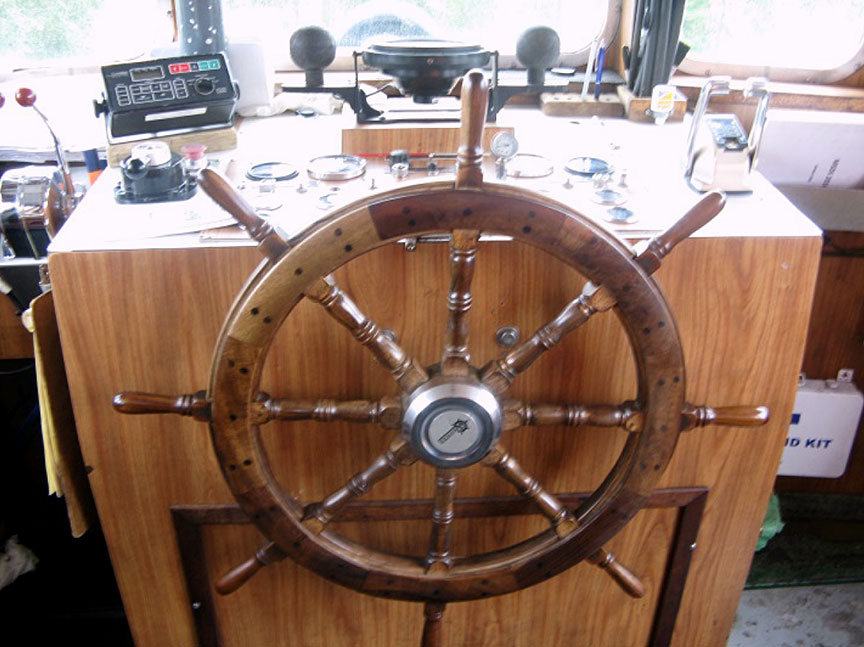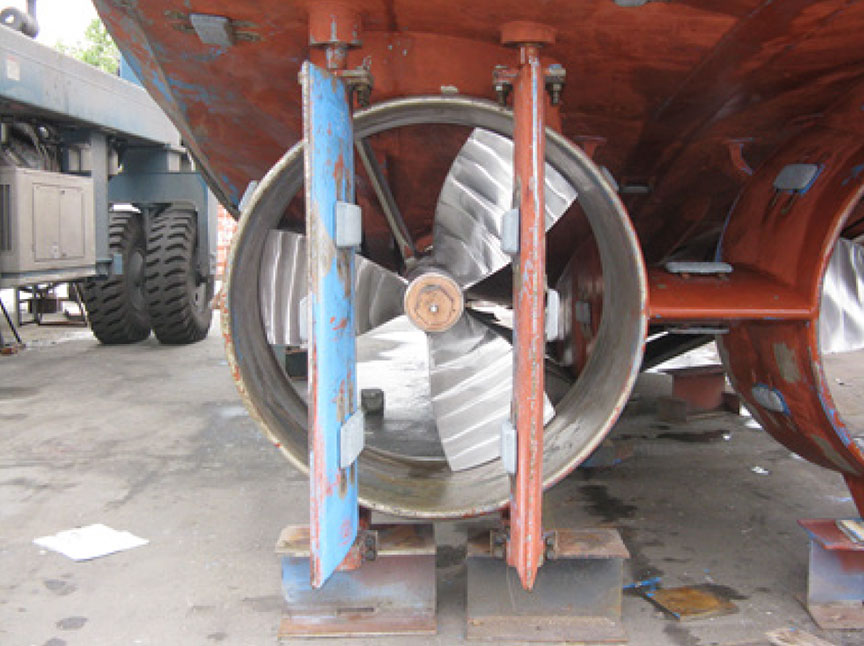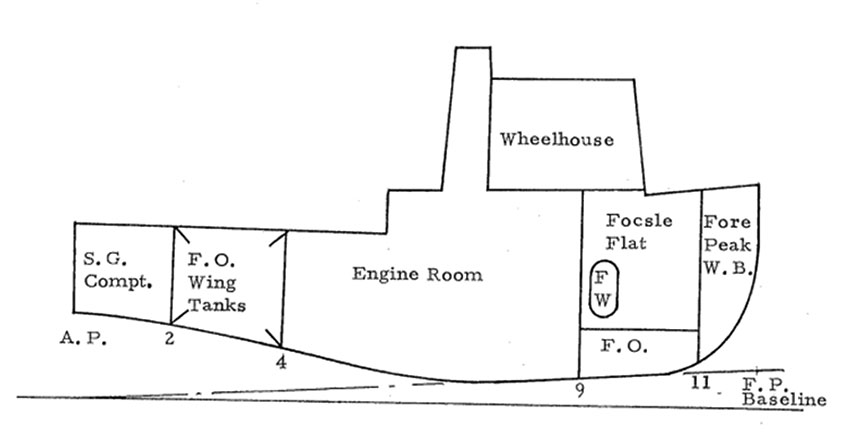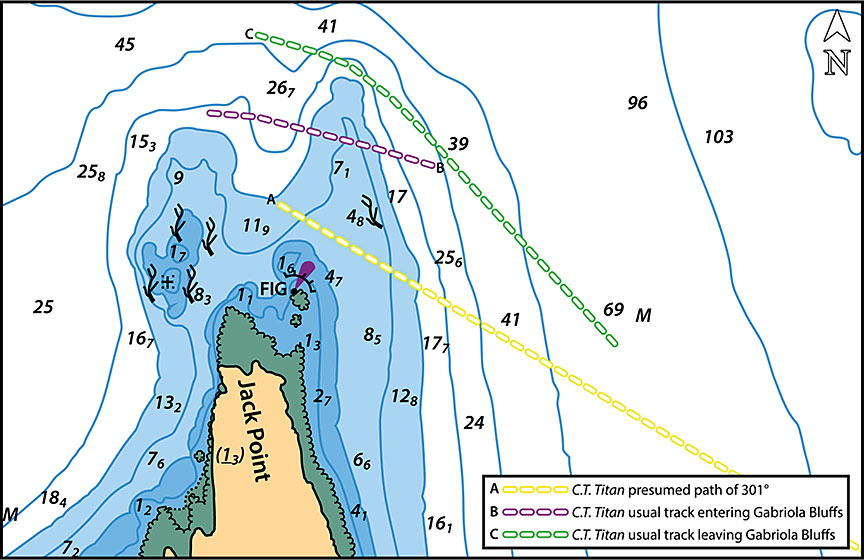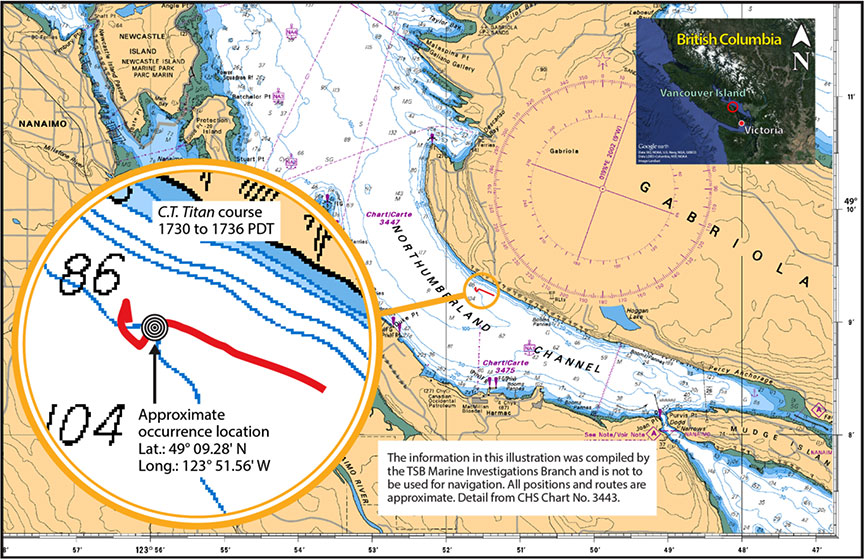Collision and sinking
Tugs Albern and C.T. Titan
Northumberland Channel, British Columbia
The Transportation Safety Board of Canada (TSB) investigated this occurrence for the purpose of advancing transportation safety. It is not the function of the Board to assign fault or determine civil or criminal liability. This report is not created for use in the context of legal, disciplinary or other proceedings. See Ownership and use of content. Masculine pronouns and position titles may be used to signify all genders to comply with the Canadian Transportation Accident Investigation and Safety Board Act (S.C. 1989, c. 3).
Summary
On 24 May 2016, at approximately 1730 Pacific Daylight Time, the tug C.T. Titan collided with the tug Albern in Northumberland Channel, British Columbia. The Albern capsized and sank, and the vessel's 2 crew members were rescued by the crew of the C.T. Titan. The C.T. Titan sustained damage to its hull; the Albern was not recovered. Minor pollution was reported.
This report is also available in English.
1.0 Factual information
1.1 Particulars of the vessels
| Name of vessel | Albern | C.T. Titan |
|---|---|---|
| Official number | 328292 | 391718 |
| Port of registry | Vancouver | Nanaimo |
| Flag | Canada | Canada |
| Type | Tug | Tug |
| Gross tonnage | 9.43 | 53.91 |
| Length | 9.81 m | 15.24 m |
| Built | 1967, United Engineering Ltd., Victoria, BC | 1979, Allied Shipbuilders Ltd., North Vancouver, BC |
| Propulsion | 1 diesel engine (272.18 kW) driving a fixed-pitch propeller | 2 diesel engines (700.96 kW total) driving 2 fixed-pitch propellers |
| Crew | 2 | 3 |
| Registered owner | Jones Marine Group Ltd., Chemainus, BC | Jones Marine Group Ltd., Chemainus, BC |
1.2 Description of the vessels
1.2.1 Albern
The Albern was a single-screw, steel-hulled, pointed bow tug with a rounded stern (Figure 1). The main deck had a bulwark, and the bow had fenders to protect it during operations such as pushing and log yarding. An aluminum wheelhouse was located on the fore part of the main deck, and there was a flying bridge atop the wheelhouse. Below the main deck were 3 transverse bulkheads that created 4 compartments (from forward): the forepeak, the forecastle, the engine room, and the lazarette.
The wheelhouse was accessible from the main deck through 2 weathertight doors located on its port and starboard sides. The wheelhouse was equipped with a propulsion control unit, steering controls, radar, an echo sounder, and a very high frequency (VHF) radiotelephone with digital selective calling. The flying bridge atop the wheelhouse was fitted with propulsion controls and hand steering.
The forecastle was used as a storage area and was accessible through a raised watertight hatch on the foredeck. The engine room was accessible through a raised watertight hatch on the main deck. The engine room contained 2 fuel tanks fitted on the port and starboard sides; each had a capacity of 946 L.
1.2.2 C.T. Titan
The C.T. Titan is a twin-screw, steel-hulled, pointed bow tug with a rounded stern (Figure 2). The main deck forward of the wheelhouse has a bulwark, and the bow has fenders to protect it during operations such as pushing and log yarding.
An aluminum wheelhouse is located on the fore part of the main deck, and is accessible from the main deck through weathertight doors located on its port and starboard sides. The wheelhouse is equipped with a propulsion control unit, steering controls, radar, an autopilot, an electronic chart plotter, a global positioning system, and 2 VHF radiotelephones with digital selective calling.
Above the wheelhouse is a flying bridge that is accessible by an external ladder located just aft of the starboard wheelhouse door. The flying bridge is equipped with a propulsion control unit, steering controls, and a remote VHF radiotelephone handset.
A towing winch is located aft of the wheelhouse, with a control station beside it; this winch control station includes the towing winch controls, a propulsion control unit, and steering controls.
Below the main deck are 4 transverse bulkheads that create 5 compartments (Appendix A), including the engine room. The engine room is accessible through a hatch with a coaming, located amidships on the starboard side at the main deck level. Two equally powered main engines provide propulsion through 2 ducted propellers.Footnote 1
The steering gear system consists of 2 sets of rudders, which are located immediately aft of each propeller (Figure 3). All 4 rudders operate synchronously; for example, moving the steering control to port moves all 4 rudders to the port side.
1.3 Company operations
In addition to the Albern and C.T. Titan, the company owns 4 other tugs with a gross tonnage (GT) of less than 15, and 3 other tugs greater than 15 GT. The tugs are used for various services, including log yarding.
Company tugs engaged in logging operations work at multiple sites, such as at log booms, along channels, and along rivers near Vancouver or Vancouver Island. At the time of the occurrence, the C.T. Titan and Albern were assigned to log yarding operations at Gabriola Bluffs.
1.4 History of the voyage
On 24 May 2016, at 1728 Pacific Daylight Time,Footnote 2 after completing the daily log yarding operations, the Albern departed for Nanaimo Harbour for a crew change. The master and the deckhand were in the wheelhouse, with the master at the helm. The vessel's speed was around 5 knots.Footnote 3
At approximately 1729, the C.T. Titan, with 3 people on board, also departed the log yard, heading towards Nanaimo Harbour for a crew change. The C.T. Titan travelled at a speed of about 9.5 knotsFootnote 4 on a heading of 296°T. The C.T. Titan travelled parallel to the Albern's course, about 15 m away from its starboard side and about 22 m behind its stern. The master of the C.T. Titan navigated from the flying bridge, and used the jogFootnote 5 to maintain a relatively straight course, averaging 292°T.
At 1731, the master altered the vessel's course to 301°T, on a heading that was about 0.2 nm off Jack Point (Appendix B). The 2 deckhands on the C.T. Titan were inside the wheelhouse facing the vessel's stern, preparing for the crew change.
Soon after, the master of the C.T. Titan visually verified that the C.T. Titan was moving on a course parallel to the Albern. The master on the C.T. Titan then left the flying bridge to navigate from the wheelhouse. The hand levers on the flying bridge propulsion control unit were at full ahead and the flying bridge rudder angle indicator was at about amidships. The hand levers on the propulsion control unit in the wheelhouse were at neutral. At this time, the C.T. Titan was about 15 m behind the Albern's stern, and 15 m apart from the Albern, on the Albern's starboard side (Figure 4; Appendix C).
The master entered the C.T. Titan's wheelhouse 6 to 8 seconds later and noticed that the C.T. Titan had veered to port and was about to strike the Albern. The master of the C.T. Titan made several attempts to transfer propulsion control to the wheelhouse unit, but was unable to do so. Approximately 10 secondsFootnote 6 after the master left the flying bridge (2 to 4 seconds after the master entered the wheelhouse), the C.T. Titan's bow struck the Albern's starboard quarter. The Albern capsized and trapped its 2 crew members underwater (Appendix D). The Albern's deckhand escaped the vessel's flooded wheelhouse through the wheelhouse door, and the Albern's master escaped through a shattered wheelhouse window; both the master and the deckhand swam to the surface.
Upon striking the Albern, the C.T. Titan veered approximately 90° to port (heading 215°T) and then ran up onto the hull of the capsized Albern. Soon after, the C.T. Titan's master regained propulsion control and backed the vessel away from the Albern. The C.T. Titan sustained damage to its keel cooler.Footnote 7
At approximately 1743, the Albern sank in about 100 m of water near the occurrence location.Footnote 8 The C.T. Titan's crew rescued the Albern's master and deckhand from the water. Over the next hour, the C.T. Titan's crew retrieved the Albern's uninflated life raftFootnote 9,Footnote 10 along with other items from the Albern that were floating nearby. At approximately 1900, the owner's crew boat arrived and transported both rescued crew members to Nanaimo Harbour.
The crew members of the C.T. Titan temporarily repaired the damaged tube of the vessel's port keel cooler. The next day, the vessel travelled to a commercial shipyard in Richmond, British Columbia, for repairs.
1.5 Environmental conditions
The weather at the time of the occurrence was clear with good visibility of approximately 10 nm. There was a south-southeasterly wind of 5 to 10 knots and a southeasterly swell of approximately 0.1 m. The air temperature was 16 °C and the surface water temperature was approximately 9 °C.Footnote 11
1.6 Damage to the vessels
1.6.1 Albern
In June 2016, the Nanaimo Port Authority sent a remotely operated vehicle to the occurrence site and captured underwater video footage of the sunken vessel to assess the extent of the damage and the feasibility of salvaging the vessel to clear the channel. The video footage identified that the hatch cover to the forecastle was open. The assessment concluded that salvaging the vessel was not viable, and the vessel was declared a constructive total loss.
When the Albern capsized and sank, it was carrying 800 L of fuel oil and 200 L of hydraulic oil. Minor pollution was reported.
1.6.2 C.T. Titan
The C.T. Titan sustained damage to the outer shell plate of its starboard keel cooler. The damage was repaired at a commercial shipyard following the occurrence, and the C.T. Titan returned to service on 12 August 2016.
1.7 Personnel certification and experience
1.7.1 Albern
The master held the certificate Master, Limited for a Vessel of less than 60 GT, issued in 2013, with restrictions to operate between Race Rocks and Cape Caution. The master also held a Chief Mate 150 GT Domestic certificate, valid for a vessel up to 150 GT engaged on a near coastal voyage. The master started his marine career with the company in 2002 and had served as a master since 2014 on board various tugs owned by the company.
The deckhand held a Marine Emergency Duties certificate and had worked for the company since 2014.
1.7.2 C.T. Titan
The master held the certificate Master, Limited for a Vessel of less than 60 GT, issued in 2016, with restrictions to operate between Race Rocks and Cape Caution. The master also held a Watchkeeping Mate, Near Coastal certificate that was issued in 2016 and was valid for near coastal or sheltered water voyages.Footnote 12 The master started his marine career with the company in 1994, and had worked as a master since 2001 on board various tugs owned by the company.
The regular deckhand had worked for the company since October 2012. The other deckhand had joined the company 24 days before the occurrence and underwent training on board the C.T. Titan 1 week before the occurrence. Both deckhands held Marine Emergency Duties certificates.
1.8 Vessel certification
1.8.1 Albern
The Albern was crewed and equipped in accordance with existing TC regulations. The tug did not carry an inspection certificate,Footnote 13 nor was it required to carry one.
1.8.2 C.T. Titan
The C.T. Titan was crewed and equipped in accordance with existing Transport Canada (TC) regulations. At the time of the occurrence, the tug held a quadrennial inspection certificateFootnote 14 that had expired on 08 February 2016. The inspection certificate permitted the tug to operate as a non-passenger vessel on Near Coastal, Class 2 voyages in Canadian waters.
1.9 Propulsion control on the C.T. Titan
The C.T. Titan has 3 identical propulsion control units, located in the wheelhouse (Figure 5), on the flying bridge, and near the towing winch. Each unit has a hand steering wheel and a jog, and 2 hand levers (Figure 6) that control the port and starboard main engines' revolutions and the propeller shafts' rotational direction individually.
When the hand levers are positioned between 0° and 25° in either forward or reverse, the vessel is in a neutral idling position (Figure 7). Notches at the 0° and 25° positions provide tactile feedback to help the operator locate these positions by touch when using the hand levers. Green lamps beside the neutral (N) indicator on the propulsion control unit light up when the propulsion control is successfully transferred to another propulsion control unit with the hand levers at the neutral position (0°). Moving the active control station hand levers beyond 25° in either forward or reverse will shift the engines to the corresponding throttle position, and the vessel will accelerate accordingly. Orange lamps beside the forward (F) and reverse (R) indicators on the propulsion control unit will illuminate to indicate that the vessel is in forward or reverse gear and is moving either ahead or astern.
1.9.1 Procedure for propulsion control transfer between stations when control is at neutral
Vessel propulsion can be controlled from only one station at a time.Footnote 15 At the station where control is to be transferred, the operator sets the propulsion control levers to neutral (0°) and depresses the yellow SELECT button momentarily. The 2 green neutral (N) lamps illuminate continuously to indicate that the control transfer was successful (Figure 6).
1.9.2 Procedure for transferring propulsion control between stations when control is in gear
To transfer propulsion control to another control station while the vessel is in gear, the operator goes to the other control station, sets the hand levers to neutral, and depresses the SELECT button. The 2 green neutral (N) lamps illuminate continuously to indicate that the control transfer was successful (Figure 6).
Once control has been transferred, the operator has 4 seconds to move both the hand levers at the new control station so they match the position of the hand levers at the last active control station (for example, if the hand levers were at full ahead at the last active station, they must be put to full ahead at the new station). If this task is completed successfully, the orange forward (F) lamps at the new control station will illuminate to indicate that the new station is now active, and the vessel will continue operating without reducing its speed. If, for any reason, the operator does not match the position of the hand levers at the new station within 4 seconds, propulsion control will remain with the last active station, and the operator must repeat the entire procedure.
1.10 On-board work practices
During operations such as log yarding, masters of company vessels left the flying bridge multiple times per day with their vessels in gear. The decision of when to leave the flying bridge was left to the discretion of the master of each vessel. Regular deckhands on board these vessels were aware of the need for the master to leave the flying bridge.
The deckhand who regularly worked on the C.T. Titan had an informal practice of acting as a lookout as the master moved between control stations. At the time of the occurrence, the company did not have formal guidelines in place regarding the procedures for masters to move between control stations.
1.11 Hazards of unsafe routine operations
An operator will perceive hazards or risks associated with a task that is performed routinely without negative consequences as low or acceptable. This lower (and false) perception is referred to as reduced perception.Footnote 16, Footnote 17, Footnote 18
Procedures for transferring propulsion control between stations on board the C.T. Titan had evolved informally over time and were verbally passed on from one master to another during deckhand training. Consequently, masters of the C.T. Titan, including the master involved in this occurrence, used the informal practice of transferring propulsion control multiple times a day while the vessel was in gear. Also, masters often transferred propulsion control in this manner with the last active control station unattended, as the master's focus was usually on completing the task at hand in a timely manner to meet operational requirements. Because this informal practice was performed repeatedly over the years without any risk assessment and without adverse consequences, the masters perceived the hazards associated with this practice as low, or acceptable.
1.12 Post-occurrence examination of the vessels
On 25 May 2016, the TSB conducted tests on all 3 of the C.T. Titan's propulsion control stations and observed no abnormalities with the propulsion control transfer system.
TSB investigators also examined the vessel and made the following observations:
- Both port and starboard rudders were undamaged, and the port outer (blue) rudder and the starboard inner rudder were misaligned towards the port side. These misalignments were visually estimated to be approximately 3° (Figure 8).
- The rudder angle indicators at the flying bridge and winch control stations were not consistent with the rudder angle indicator in the wheelhouse. There was a 1.5° to 2° error on the indicator at the flying bridge and about a 0.5° error on the indicator at the winch station.
The Albern was not recovered after it sank, which precluded an inspection. A post‑occurrence inspection of the Albern's uninflated life raft revealed that the painter attached to the life raft had not been tied to any part of the vessel. Therefore, when the Albern sank, the life raft strap was released by the hydrostatic unit, as designed, but the life raft did not inflate.
1.12.1 Sea trials
On 13 August 2016, a sea trial was conducted in the Fraser River, British Columbia, to evaluate the C.T. Titan's characteristics, in an attempt to recreate the scenario that led to the occurrence.
During the sea trial, 2 company masters, a deckhand, an engineer, and 2 TSB investigators were on board. Several trips were made back and forth along the Gravesend Reach, Fraser River, British Columbia. No abnormalities were observed with the propulsion control transfer system. It was observed that the vessel would veer slightly to port or to starboard, even though the rudder angle indicator showed that the rudders were at amidships and the master had to use the jog to manually correct the veering angle and ensure that the vessel could proceed in a straight line.
1.13 Transport Canada inspection and certification
Tugs greater than 15 GT, such as the C.T. Titan, are required to carry a valid TC inspection certificate at all times while in operation. These tugs are required to be inspected before they can be certificated, and then again periodically by TC. The responsibility for maintaining the validity of this certificate rests with the authorized representative (AR), as noted in subsection 106(2) of the Canada Shipping Act, 2001 (CSA 2001).
On 12 August 2016, after repairs were completed, TC inspected the C.T. Titan and issued a quadrennial inspection certificate that was valid until 12 September 2020. During the inspection, TC identified various deficiencies and issued a Deficiency Notice to the AR,Footnote 19 flagging missing emergency procedures and defective wheelhouse gauges, and setting a compliance due date of 12 September 2016. The Notice gave the reference act for all the deficiencies as "CSA, 2001." The Notice did not detail which wheelhouse gauges were defective or the types of defects the gauges had. The AR reported to TC that all the deficiencies noted were corrected by 07 September 2016.
In December 2016, the TSB's investigation found that the AR had developed only 2 shore‑based emergency procedures (fire and evacuation), and was still developing shipboard emergency procedures for the C.T. Titan, such as collision, striking, grounding, and steering failure.
1.14 International Regulations for Preventing Collisions at Sea
The International Regulations for Preventing Collisions at Sea (COLREGS) are a convention that establishes, among other things, the rules of conduct to follow at sea when a risk of collision exists between vessels. These rules have been adopted by Canada and "apply to all vessels upon the high seas and in all waters connected therewith navigable by seagoing vessels."Footnote 20
Rule 5 of the COLREGS states that
Every vessel shall at all times maintain a proper look-out by sight and hearing as well as by all available means appropriate in the prevailing circumstances and conditions so as to make a full appraisal of the situation and of the risk of collision.Footnote 21
Rule 6 of the COLREGS states that
Every vessel shall at all times proceed at a safe speed so that she can take proper and effective action to avoid collision and be stopped within a distance appropriate to the prevailing circumstances and conditions.Footnote 22
Rule 13A of the COLREGS states that
Any vessel overtaking any other vessel shall keep out of the way of the vessel being overtaken.Footnote 23
Knowledge and application of the COLREGS form a component of the syllabus for a Master, Limited for a Vessel of less than 60 GT certificate.Footnote 24
1.15 Management of safety
The principal objectives of a safety management system (SMS) on board a vessel are to ensure safety at sea, prevent human injury or loss of life, and avoid damage to property and the environment. Safety management involves individuals at all levels of an organization and requires that a systematic approach be taken in identifying and mitigating operational risks.
Some elements of an effective SMS include the following:
- operating procedures for the vessel and the use of checklists
- maintenance procedures for the vessel and its associated equipment
- documentation and record-keeping procedures
- procedures for identifying hazards and managing risks
- procedures to prepare for, and respond to, emergency situations
- drills, training, and familiarization for the vessel's crew.
Although the benefits of an SMS have long been recognized by the marine community, TC regulations do not require all marine companies and operators to operate under an SMS, nor is an SMS required on all types of vessels. In this occurrence, neither the AR nor the vessels operated under an SMS, nor were they required to do so.
In 2010, TC began formal consultations on a regulatory proposal to introduce safety management regulations to Canadian non-convention vessels,Footnote 25 including those less than 15 gross registered tons. However, industry expressed concerns—primarily related to costs and feasibility—that the new regulations would be too onerous for companies that operate small vessels to implement. In response to stakeholder concerns, TC amended its regulatory proposal in 2012 to include only vessels greater than 24 m in length and those carrying more than 50 passengers.
1.15.1 Vessel management
Under the CSA 2001 and the Marine Personnel Regulations, a vessel's AR is responsible for
- ensuring that the vessel and its machinery and equipment meet the requirements of regulations set out by the CSA 2001;Footnote 26
- developing procedures for the safe operation of the vessel and dealing with emergencies;Footnote 27 and
- ensuring that any person assigned a function on board a vessel receives the on-board familiarization and safety training as noted in the Marine Personnel Regulations.Footnote 28
Supporting documentation and records must be available to any person or organization authorized under the CSA 2001 to carry out inspections.
The company had developed a safety manual entitled Vessel Safety Documents, which was on board the C.T. Titan at the time of the occurrence. The manual included the master's safety responsibilities and procedures for ship berthing, as well as crew familiarization checklists, employee performance evaluations, drill reports, critical incident stress information, weekly vessel equipment inspection reports, and incident reporting forms. The company had also documented marine emergency procedures for man overboard and fire, but these documents were not on board the C.T. Titan at the time of the occurrence.
With respect to employee fitness for duty, the safety manual stated it was the master's responsibility to "[e]nsure that all crew's ability to work safely is not impacted by alcohol consumption, drug or substance abuse, fatigue or any other form of impairment."Footnote 29 The company assessed the competence and skills of new employees or workers who had been away from the job for more than 6 weeks using its Worker Assessment Checklist and Employee Performance Report. The assessment forms did not assess medical fitness.
The company also had a maintenance procedure in effect that required defects to be rectified and recorded in a timely manner. Maintenance records dating back to October 2015 did not identify any issues with the rudders or rudder indicators.
1.15.1.1 Vessel maintenance
Between 28 March and 04 April 2016, the C.T. Titan underwent routine maintenance at a commercial dry-dock. As part of this maintenance, all 4 rudders and rudder stocks were dismantled. The rudder stock bolt holes were repaired and realigned to fit the rudder flange holes, and maintenance to the steering gear was carried out. Following completion of the steering gear maintenance, the rudders were reinstalled. The maintenance records did not indicate whether the rudder alignment was checked following the reinstallation of the rudders. Also, there was no record indicating that the engine controls were tested.
1.16 Previous occurrences
Between January 2011 and May 2016, the TSB received reports of 15 occurrences in British Columbia (including this occurrence) of tugs sinking.Footnote 30 Of these occurrences, 1 of the tugs that sank was greater than 15 GT and the rest were less than 15 GT.
A previous TSB reportFootnote 31 has also addressed issues with respect to the fitness for duty of seafarers. This report identified the absence of complete seafarer medical information in medical reports provided by medical examiners designated by regulatory bodies, a lack of sufficient disclosure validation methods during the marine medical examination, and a failure to verify ongoing medical fitness of crew members.
1.17 Medical examination of seafarers
Seafarers who are required to hold a Certificate of Competency are also required to hold a valid marine medical certificate, with 5 exceptions.Footnote 32 One of these exceptions is Master, Limited for a Vessel of less than 60 GT that is not a passenger-carrying vessel. On the basis of this exception, the master of the C.T. Titan was not required to undergo a marine medical examination.
Seafarers who require a marine medical certificate must undergo a medical examination conducted by a marine medical examiner (MME), who is a physician designated by TC. MMEs are required to assess the seafarer's health against the standardsFootnote 33 set out by TC and to "obtain any relevant documentation so that a proper assessment may be made with regard to the examinee's medical condition and public safety."
Based on the medical examination, the MME deems the seafarer fit, fit with limitations, or unfit, and issues a provisional medical certificate that is valid for 6 months. The MME's decision is sent to TC's Marine Medical unit for review. If the review finds that the seafarer is fit for duty, with or without any need for operational limitations, an official marine medical certificateFootnote 34 valid for 2 years is issued by the Minister of Transport.
The aim of the medical examination is to ensure that the seafarer is fit to perform their duties according to minimum performance requirements with respect to vision, hearing, physical capabilities, impairment from medication, or presence or recent history of an illness or condition.Footnote 35 During the examination, MMEs rely on the seafarer to self-report medication use and medical conditions, as it is the seafarer's responsibility to provide relevant medical history and to sign a disclosure under the CSA 2001.
1.17.1 Master's marine medical examinations
The master of the C.T. Titan underwent a TC marine medical examination in 2016 (2 months prior to the occurrence) as required by company policy to renew his Watchkeeping Mate, Near Coastal certificate. Under section 16 of the CSA 2001, seafarers are responsible for making a true declaration of their relevant medical history during each medical examination, and of their medical conditions and related treatments, and for disclosing these to the MME. The master's physical health was assessed as satisfactory and within the required standards.
1.17.2 Master's medical condition
The master of the C.T. Titan's medical history since 2013 showed that the master had chronic medical conditions that could affect job performance, and that the master was receiving long-term treatment and medications for these conditions. The master's family physician was aware that the master was a master of a tug. The physician had no concerns related to the master's ability to perform his duties, but was not aware of physicians' reporting obligations to TC.
1.17.3 Medical professionals' duty to inform Transport Canada
The CSA 2001 requires that the Minister of Transport be provided with information if a medical professional believes on reasonable grounds that the certificate holder has a medical condition that is likely to constitute a hazard to maritime safety.Footnote 36 Medical professionals are informed about their duty to report to Transport Canada Marine Safety and Security through medical publications, which medical professionals can refer to as needed.Footnote 37 It is the medical professional's obligation to know the CSA 2001's reporting requirements. Medical professionals can request legal advice from the Canadian Medical Protective Association if they have any questions about their legal obligation to report.
On 13 January 2012, the TSB discussed physicians' reporting responsibility with TC marine personnel and its marine medical team. In January 2014, TC informed the TSB that it had advised the Canadian Medical Protective Association about the legal requirements of Canadian physicians to report under section 90 of the CSA 2001.
1.18 TSB Watchlist
Safety management and oversight will remain on the TSB Watchlist until
- Transport Canada implements regulations requiring all commercial operators in the air and marine industries to have formal safety management processes and effectively oversees these processes;
- transportation companies that do have SMS demonstrate that it is working—that hazards are being identified and effective risk-mitigation measures are being implemented; and
- Transport Canada not only intervenes when companies are unable to manage safety effectively, but does so in a way that succeeds in changing unsafe operating practices.
The Watchlist identifies the key safety issues that need to be addressed to make Canada's transportation system even safer.
Safety management and oversight is a Watchlist 2016 issue. As this occurrence demonstrates, some transportation companies are not effectively managing their safety risks, and TC oversight and intervention have not always proven effective at changing companies' unsafe operating practices.
2.0 Analysis
The Transportation Safety Board of Canada's investigation into the collision between the C.T. Titan and the Albern determined that the master of the C.T. Titan left the propulsion and steering controls unattended for 6 to 8 seconds while he moved from the flying bridge to the wheelhouse and could not regain control in time to avoid striking the Albern. The investigation determined that the master's medical conditions did not contribute to this occurrence.
This analysis will focus on the operator's risk perception, vessel management, and regulatory oversight, and their contribution to the accident.
2.1 Factors leading to the collision and sinking
When the master of the C.T. Titan left the flying bridge with the propulsion control at full ahead and within close proximity of the Albern, the C.T. Titan veered to port and collided with the slower-moving Albern. The master of the C.T. Titan routinely changed propulsion control stations while the vessel was full ahead, and a deckhand would often assume lookout duties when the master temporarily left the propulsion controls unattended. In this occurrence, the master assessed the risk of leaving the flying bridge unattended as low, and therefore did not specifically task either of the deckhands on board with lookout duties.
The investigation determined that it was the vessel's tendency to veer to port or to starboard when the steering controls were unattended, as well as the rudders' misalignment to port, that likely led to the C.T. Titan veering to port.
When the C.T. Titan veered to port, its proximity to the Albern meant that the master had only 2 to 4 seconds to respond to the situation and could not successfully complete the process of transferring propulsion control in such a short time.
The momentum of the C.T. Titan and the force of impact on the Albern's starboard quarter caused the Albern to capsize. The Albern subsequently sank due to downflooding through various non-watertight openings and the forward watertight hatch, which was open while the vessel was under way.
2.2 Reduced perception about the hazards of routine operations
Procedures for transferring propulsion control between stations on board the C.T. Titan had evolved informally over time, and were verbally passed on from one master to another during deckhand training. Consequently, masters of the C.T. Titan, including the master involved in this occurrence, employed the informal practice of transferring propulsion control while the vessel was in gear multiple times a day. Also, masters often transferred propulsion control in this manner with the last active control station unattended, as the master's focus was usually on completing the task at hand in a timely manner to meet operational requirements. Because this informal practice was performed repeatedly over the years without any risk assessment and without adverse consequences, the masters perceived the hazards associated with this practice as low, or acceptable.
If unsafe work practices are performed repeatedly by operators, and without operators experiencing any adverse consequences, then there is a risk that operators will have a reduced perception of the hazards involved in that practice and will continue to perform it.
2.3 Vessel management
An authorized representative (AR) requires a structured and efficient approach to the management of the vessels' personnel and equipment for the company to operate safely and effectively. This approach includes adhering to the Canada Shipping Act, 2001 (CSA 2001) and the Marine Personnel Regulations, which indicate that the AR must provide their crew with standardized guidance for safely carrying out operations on board a company vessel.
The safety manual on board the C.T. Titan contained only 1 safe operating procedure (ship berthing). There were no documented safe operating procedures for other common aspects of the vessel's operations, such as the transfer of propulsion control and autopilot/jog steering operations.
Documented safe operating procedures for the transfer of propulsion control on company vessels would have provided the master of the C.T. Titan with formal guidance for the circumstances under which it was safe to leave the bridge unattended while transferring propulsion control, as well as how to mitigate the risks associated with this practice.
Furthermore, the investigation found the following shortcomings in the company's management of the C.T. Titan:
- There was no system in place to track the vessel's inspection certificates and expiry dates, and the vessel's Transport Canada (TC) inspection certificate had expired 3 months prior to the occurrence. As such, safety critical items might not be maintained in a timely manner, leading to performance issues during operation.
- Although there were records of the maintenance to critical equipment that was done by external contractors, the AR did not have the test records for this maintenance, which would allow for verification that the maintenance had been carried out correctly. For example, there was no reference data to confirm that the correct rudder alignment was achieved after repairs to the rudder and rudder stock bolt holes were made. Further, TC found defective gauges during its quadrennial inspection, which was conducted after the vessel underwent a 3-month repair period following the occurrence.
If companies do not have a process for managing vessel safety, including the development of safe operating procedures for routine operations, there is a risk that deficiencies in vessel equipment and practices may go unidentified or unaddressed, compromising the safety of the vessel and its crew.
2.3.1 Reporting obligations related to medical fitness
Under section 16 of the CSA 2001, seafarers are responsible for making a true declaration of their relevant medical history during each medical examination they undergo, to enable the medical examiner to identify any potential medical risks.
Although the master of the C.T. Titan had undergone a marine medical examination in 2016 and held a valid marine medical certificate,Footnote 38 neither TC nor the marine medical examiners had knowledge of the master's chronic medical conditions and his related treatments at the time of the occurrence; these were not all disclosed in the medical report submitted to TC. Therefore, it was not possible for the marine medical examiners to conduct a detailed medical assessment of the master and determine the degree to which the master's medical condition and related treatments would impact his fitness for duty.
The investigation also determined that the master's family physician was not aware of the responsibility to inform TC if a physician has reasonable grounds to believe that their patient is likely to constitute a hazard to maritime safety. Despite several means for medical professionals to become informed about their duty to report, this message has not reached all physicians.
2.4 Regulatory oversight
2.4.1 Authorized representative's reporting responsibility
According to the CSA 2001, it is the AR's responsibility to notify TC when one of their vessels needs an inspection; this notification must be sent before the expiry of that vessel's inspection certificate. TC places the onus on ARs to ensure that their vessels carry a valid inspection certificate while in operation, and there is no procedure in place to notify ARs that their vessels' inspection certificates have expired. In addition, TC does not have a procedure in place to check for vessels that may be operating with expired inspection certificates.
Although TC has jurisdiction to conduct random inspections outside of its regular inspections, typically these random inspections take place only after an occurrence. This means that if ARs of tugs with a gross tonnage above 15 are not fulfilling their responsibility under the CSA 2001 (as was the case with C.T. Titan), few opportunities exist to identify and/or rectify infractions until after an occurrence.
In this occurrence, the vessel's quadrennial inspection was 3 months overdue, and neither TC nor the company was aware that the C.T. Titan was operating with an invalid certificate. A quadrennial inspection would have given TC the opportunity to inspect the vessel's underwater hull section, as well as identify the vessel's misaligned rudders.
If regulatory inspections are not carried out at the required frequency, then there is a risk of vessels operating with defective safety critical equipment.
3.0 Findings
3.1 Findings as to causes and contributing factors
- The master of the C.T. Titan left the flying bridge while overtaking the Albern at full speed, leaving the navigational control temporarily unattended for 6 to 8 seconds.
- The C.T. Titan veered to port, most likely because of the vessel's misaligned rudders.
- The master of the C.T. Titan could not take wheelhouse propulsion control in a timely manner.
- The force of impact of the C.T. Titan on the Albern's starboard quarter pushed the Albern over and caused it to capsize.
- The Albern sank due to downflooding.
3.2 Findings as to risk
- If unsafe work practices are performed repeatedly by operators, and without operators experiencing any adverse consequences, then there is a risk that operators will have a reduced perception about the hazards involved in that practice and will continue to perform it.
- If companies do not have a process for managing vessel safety, including the development of safe operating procedures for routine operations, there is a risk that deficiencies in vessel equipment and practices may go unidentified or unaddressed, compromising the safety of the vessel and its crew.
- If regulatory inspections are not carried out at the required frequency, then there is a risk of vessels operating with defective safety critical equipment.
3.3 Other findings
- The master of the C.T. Titan did not disclose his relevant medical conditions during his medical examination. As a result, the marine medical examiners did not have the opportunity to determine if the master's medical conditions could have an impact on the safety of the vessel and its crew.
- The family physician of the C.T. Titan's master was not aware of physicians' reporting obligations to Transport Canada.
- At the time of the occurrence, the Albern's forecastle hatch cover (a critical downflooding point) was open.
- The free end of the painter of the Albern's life raft had not been properly secured to the vessel. As a result, when the Albern sank, the life raft released and floated free above the water, but did not inflate.
- The vessel's quadrennial inspection was 3 months overdue.
4.0 Safety action
4.1 Safety action taken
4.1.4 The company
Following the occurrence, the owner hired a consulting firm to conduct a safety management system gap analysis based on the International Safety Management Code. The firm presented its report to the owner, along with a recommended action plan. As a result, the company sent 10 masters and 10 deckhands to attend a situational awareness and bridge resource management training course in a local training institute. The course covered situational awareness, watchkeeping skills and knowledge, awareness of human factors, and safe working practices. The company also developed standard operating procedures and checklists for responding to marine emergencies.
In December 2016, the authorized representative reported that the company had re‑examined the arrangements for securing the painters on all the life rafts on its vessels, and had corrected the deficiency that was present on the C.T. Titan at the time of the occurrence.
This report concludes the Transportation Safety Board of Canada's investigation into this occurrence. The Board authorized the release of this report on . It was officially released on .
Appendices
Appendix A – General arrangement for the C.T. Titan
Appendix B – Vessel's heading around Jack Point, British Columbia
Appendix C – C.T. Titan's track data
| Time | Position | Leg | Heading | Distance covered | Time | Speed |
|---|---|---|---|---|---|---|
| 17:30:29 | 49°09.2356′ N, 123°51.3568′ W |
17:30:29 to 17:30:38 |
296° | 47.3 m | 9 seconds | 5.26 m/s 10.22 knots |
| 17:30:38 | 49°09.2468′ N, 123°51.3918′ W |
17:30:38 to 17:30:47 |
291° | 49.6 m | 9 seconds | 5.51 m/s 10.71 knots |
| 17:30:47 | 49°09.2566′ N, 123°51.4301′ W |
17:30:47 to 17:30:55 |
288° | 44.5 m | 8 seconds | 5.56 m/s 10.88 knots |
| 17:30:55 | 49°09.2643′ N, 123°51.4648′ W |
17:30:55 to 17:31:03 |
294° | 44.5 m | 8 seconds | 5.56 m/s 10.81 knots |
| 17:31:03 | 49°09.2643′ N, 123°51.4982′ W |
17:31:03 to 17:31:12 |
301° | 49.2 m | 9 seconds | 5.47 m/s 10.62 knots |
| 17:31:12 | 49°09.2882′ N, 123°51.5326′ W |
17:31:12 to 17:31:22 |
273° | 44.4 m | 9 seconds | 4.94 m/s 9.60 knots |
| 17:31:22 | 49°09.2895′ N, 123°51.5691′ W |
17:31:22 to 17:31:34 |
215° | 49.6 m | 12 seconds | 4.13 m/s 8.03 knots |
| 17:31:34 | 49°09.2705′ N, 123°51.5897′ W |
17:31:34 to 17:32:29 |
320° | 40.4 m | 55 seconds | 0.73 m/s 1.419 knots |
